| dc.contributor.author | Akitaya, Hugo A. | |
| dc.contributor.author | Demaine, Erik D | |
| dc.contributor.author | Demaine, Martin L | |
| dc.contributor.author | Hesterberg, Adam Classen | |
| dc.contributor.author | Hurtado, Ferran | |
| dc.contributor.author | Ku, Jason S | |
| dc.contributor.author | Lynch, Jayson R. | |
| dc.date.accessioned | 2020-11-10T16:20:43Z | |
| dc.date.available | 2020-11-10T16:20:43Z | |
| dc.date.issued | 2017-07 | |
| dc.date.submitted | 2015-03 | |
| dc.identifier.issn | 0925-7721 | |
| dc.identifier.uri | https://hdl.handle.net/1721.1/128438 | |
| dc.description.abstract | Inspired by the Japanese game Pachinko, we study simple (perfectly “inelastic” collisions) dynamics of a unit ball falling amidst point obstacles (pins) in the plane. A classic example is that a checkerboard grid of pins produces the binomial distribution, but what probability distributions result from different pin placements? In the 50–50 model, where the pins form a subset of this grid, not all probability distributions are possible, but surprisingly the uniform distribution is possible for {1,2,4,8,16} possible drop locations. Furthermore, every probability distribution can be approximated arbitrarily closely, and every dyadic probability distribution can be divided by a suitable power of 2 and then constructed exactly (along with extra “junk” outputs). In a more general model, if a ball hits a pin off center, it falls left or right accordingly. Then we prove a universality result: any distribution of n dyadic probabilities, each specified by k bits, can be constructed using O(nk2) pins, which is close to the information-theoretic lower bound of Ω(nk). | en_US |
| dc.language.iso | en | |
| dc.publisher | Elsevier BV | en_US |
| dc.relation.isversionof | http://dx.doi.org/10.1016/j.comgeo.2017.06.011 | en_US |
| dc.rights | Creative Commons Attribution-NonCommercial-NoDerivs License | en_US |
| dc.rights.uri | http://creativecommons.org/licenses/by-nc-nd/4.0/ | en_US |
| dc.source | arXiv | en_US |
| dc.title | Pachinko | en_US |
| dc.type | Article | en_US |
| dc.identifier.citation | Akitaya, Hugo A. et al. "Pachinko." Computational Geometry 68 (March 2018): 226-242 © 2017 Elsevier B.V. | en_US |
| dc.contributor.department | Massachusetts Institute of Technology. Department of Electrical Engineering and Computer Science | en_US |
| dc.contributor.department | Massachusetts Institute of Technology. Computer Science and Artificial Intelligence Laboratory | en_US |
| dc.relation.journal | Computational Geometry | en_US |
| dc.eprint.version | Original manuscript | en_US |
| dc.type.uri | http://purl.org/eprint/type/JournalArticle | en_US |
| eprint.status | http://purl.org/eprint/status/NonPeerReviewed | en_US |
| dc.date.updated | 2019-06-10T11:52:36Z | |
| dspace.date.submission | 2019-06-10T11:52:37Z | |
| mit.journal.volume | 68 | en_US |
| mit.metadata.status | Complete | |
